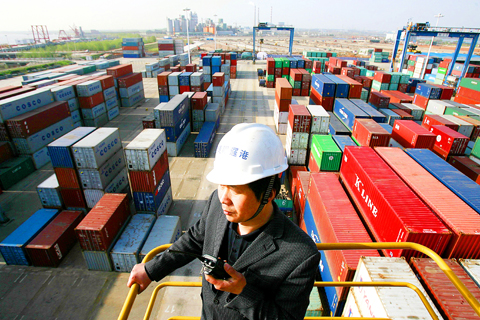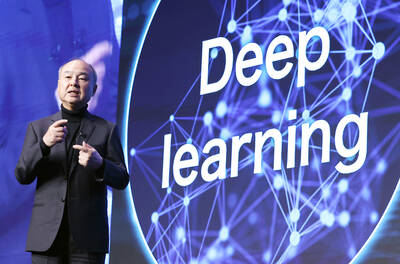The WTO said on Friday that it expected 9.5 percent growth in merchandise trade this year, a strong recovery from the steepest commercial contraction since the Great Depression.
The rebound will be led by an 11 percent growth in exports from developing countries such as China, India and Brazil, the WTO said.
Exports from wealthy nations should rise 7.5 percent.

PHOTO: AFP
World trade shrank by 12.2 percent last year, as the economic crisis destroyed consumer confidence, weakened demand, damaged credit lines for exporters and, in some instances, led to increased protectionism from governments.
The WTO said it was the “sharpest decline in more than 70 years” and the world’s richest countries suffered the worst: exports plunged 13.9 percent in the US, 14.8 percent in Europe and 24.9 percent in Japan.
“We see the light at the end of the tunnel,” WTO Director-General Pascal Lamy said, “and trade promises to be an important part of the recovery.”
At the current recovery rate, global commerce will return to pre-crisis levels next year.
The WTO used trade volumes and not trade values for its assessment to avoid distortions caused by sharp changes in commodity prices or exchange rates.
In value terms, world trade crashed 23 percent to US$12.15 trillion in 2009, the Geneva-based WTO said. Commercial services exports sunk 13 percent to US$3.31 trillion for their first slowdown in 26 years.
Meanwhile, Lamy on Friday dampened hopes for a swift conclusion to the Doha global trade liberalization talks.
“The outcome is that we are not where we wanted to be,” Lamy said after a week of meetings of the 153 WTO member states on ways to reach a deal on the long-running negotiations this year.
“Yes, we made some limited progress since [2008], but obviously not enough to enter into the final game, which will take some time,” Lamy added.
The Doha talks began in 2001 with a focus on dismantling obstacles to trade for poor nations. However, it has been dogged by intractable disagreements.
These include how much the US and the EU should reduce farm aid and the extent to which developing countries such as India and China should lower tariffs on industrial products.
Successive deadlines to conclude the talks have been repeatedly missed.

IN THE AIR: While most companies said they were committed to North American operations, some added that production and costs would depend on the outcome of a US trade probe Leading local contract electronics makers Wistron Corp (緯創), Quanta Computer Inc (廣達), Inventec Corp (英業達) and Compal Electronics Inc (仁寶) are to maintain their North American expansion plans, despite Washington’s 20 percent tariff on Taiwanese goods. Wistron said it has long maintained a presence in the US, while distributing production across Taiwan, North America, Southeast Asia and Europe. The company is in talks with customers to align capacity with their site preferences, a company official told the Taipei Times by telephone on Friday. The company is still in talks with clients over who would bear the tariff costs, with the outcome pending further

NEGOTIATIONS: Semiconductors play an outsized role in Taiwan’s industrial and economic development and are a major driver of the Taiwan-US trade imbalance With US President Donald Trump threatening to impose tariffs on semiconductors, Taiwan is expected to face a significant challenge, as information and communications technology (ICT) products account for more than 70 percent of its exports to the US, Chung-Hua Institution for Economic Research (CIER, 中華經濟研究院) president Lien Hsien-ming (連賢明) said on Friday. Compared with other countries, semiconductors play a disproportionately large role in Taiwan’s industrial and economic development, Lien said. As the sixth-largest contributor to the US trade deficit, Taiwan recorded a US$73.9 billion trade surplus with the US last year — up from US$47.8 billion in 2023 — driven by strong

A proposed 100 percent tariff on chip imports announced by US President Donald Trump could shift more of Taiwan’s semiconductor production overseas, a Taiwan Institute of Economic Research (TIER) researcher said yesterday. Trump’s tariff policy will accelerate the global semiconductor industry’s pace to establish roots in the US, leading to higher supply chain costs and ultimately raising prices of consumer electronics and creating uncertainty for future market demand, Arisa Liu (劉佩真) at the institute’s Taiwan Industry Economics Database said in a telephone interview. Trump’s move signals his intention to "restore the glory of the US semiconductor industry," Liu noted, saying that

AI: Softbank’s stake increases in Nvidia and TSMC reflect Masayoshi Son’s effort to gain a foothold in key nodes of the AI value chain, from chip design to data infrastructure Softbank Group Corp is building up stakes in Nvidia Corp and Taiwan Semiconductor Manufacturing Co (TSMC, 台積電), the latest reflection of founder Masayoshi Son’s focus on the tools and hardware underpinning artificial intelligence (AI). The Japanese technology investor raised its stake in Nvidia to about US$3 billion by the end of March, up from US$1 billion in the prior quarter, regulatory filings showed. It bought about US$330 million worth of TSMC shares and US$170 million in Oracle Corp, they showed. Softbank’s signature Vision Fund has also monetized almost US$2 billion of public and private assets in the first half of this year,